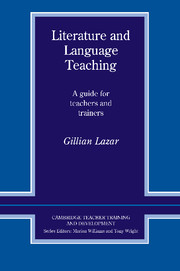Book contents
- Frontmatter
- Contents
- Thanks
- Acknowledgements
- Introduction
- 1 Using literature in the language classroom: The issues
- 2 Approaches to using literature with the language learner
- 3 Selecting and evaluating materials
- 4 Reading literature cross-culturally
- 5 Materials design and lesson planning: Novels and short stories
- 6 Materials design and lesson planning: Poetry
- 7 Materials design and lesson planning: Plays
- 8 Reflecting on the literature lesson
- 9 Literature and self-access
- Answer key
- Trainer's notes
- Bibliography
- Appendix: Eveline by James Joyce
- Index
6 - Materials design and lesson planning: Poetry
Published online by Cambridge University Press: 04 May 2010
- Frontmatter
- Contents
- Thanks
- Acknowledgements
- Introduction
- 1 Using literature in the language classroom: The issues
- 2 Approaches to using literature with the language learner
- 3 Selecting and evaluating materials
- 4 Reading literature cross-culturally
- 5 Materials design and lesson planning: Novels and short stories
- 6 Materials design and lesson planning: Poetry
- 7 Materials design and lesson planning: Plays
- 8 Reflecting on the literature lesson
- 9 Literature and self-access
- Answer key
- Trainer's notes
- Bibliography
- Appendix: Eveline by James Joyce
- Index
Summary
This chapter discusses the place of poetry in the language classroom. It begins by focussing on those aspects of poetry which are linguistically distinctive and then asks teachers to examine their own beliefs about the relevance of poetry in the language classroom. Activities for use with students at both lower and upper levels of language competence are presented for discussion. Finally, teachers have an opportunity to plan learning material for use with their own students.
Putting a poem back together again
In this section, we think about some of the distinctive features of poetry as well as ways of using poetry in the language classroom. We begin by looking at a type of activity which could be used with students. It involves the reordering of the lines of a poem.
Task 1
a) Think about the word sea. Write down any associations the word has for you.
b) Here is a poem with twelve lines. All the lines have been jumbled up so they are not in the correct order. Try to reorder them so that they make a complete poem. The title of the poem is ‘maggie and milly and molly and may’.
and molly was chased by a horrible thing
so sweetly she couldn't remember her troubles, and
went down to the beach(to play one day)
may came home with a smooth round stone
which raced sideways while blowing bubbles: and
it's always ourselves we find in the sea
maggie and milly and molly and may
and maggie discovered a shell that sang
milly befriended a stranded star
For whatever we lose(like a you or a me)
as small as a world and as large as alone.
whose rays five languid fingers were;
- Type
- Chapter
- Information
- Literature and Language TeachingA Guide for Teachers and Trainers, pp. 94 - 132Publisher: Cambridge University PressPrint publication year: 1993

